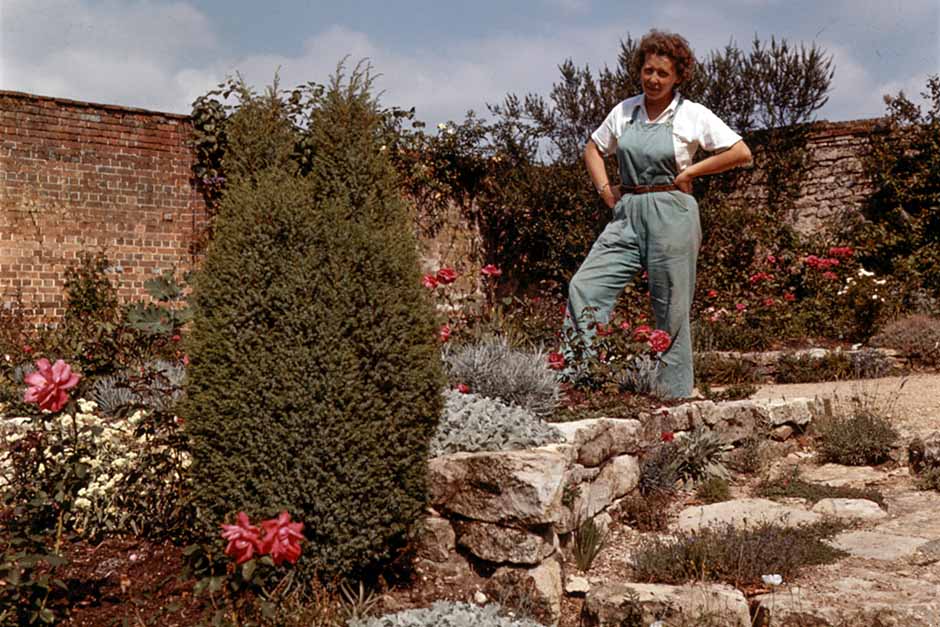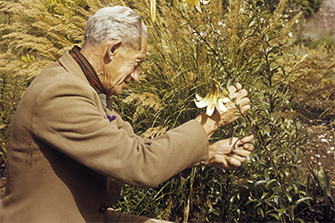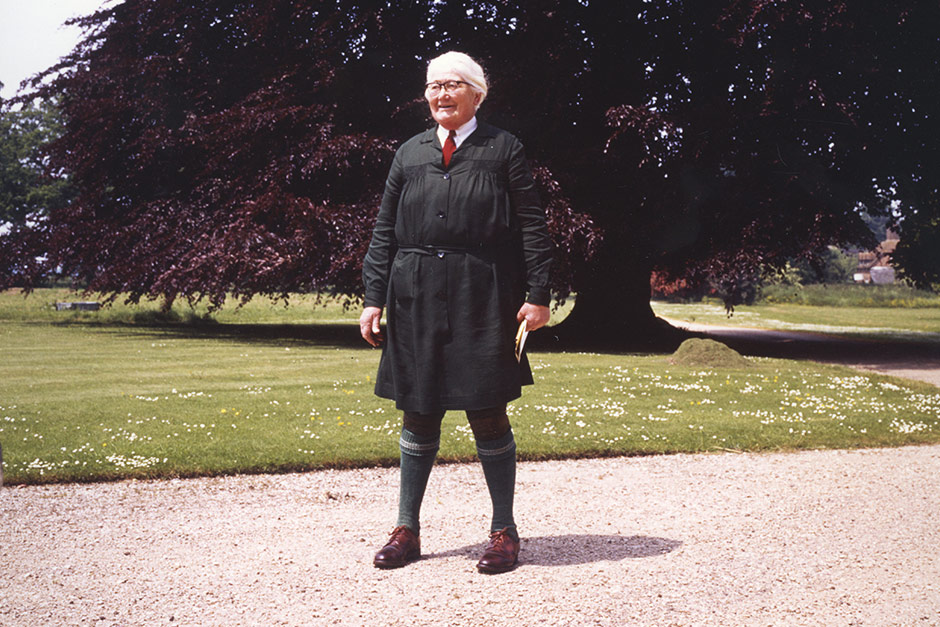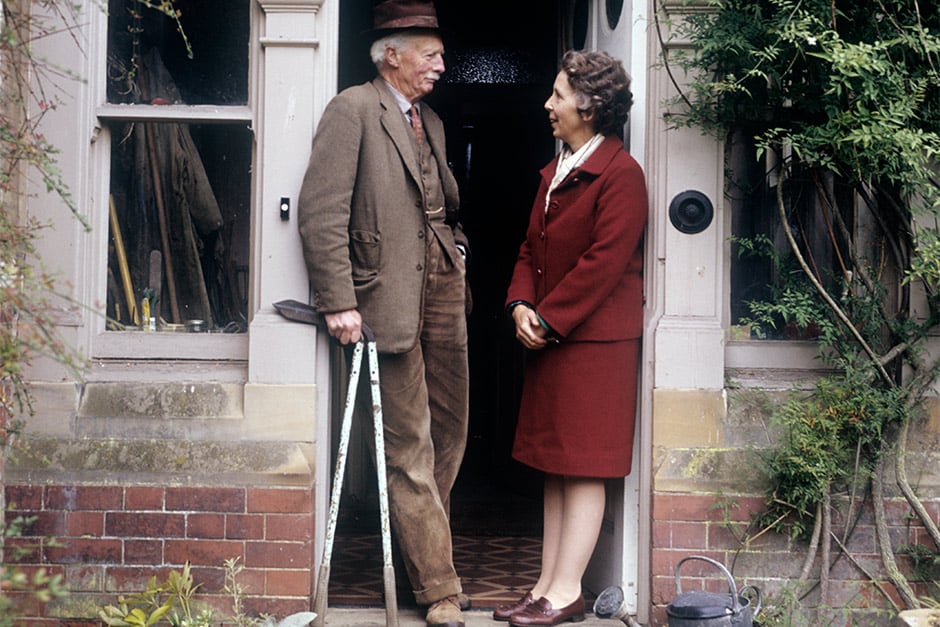The famed British plantswoman left thousands of photos from her collection to the RHS Lindley Library

On 31 October 2024, pioneering gardener and photographer Valerie Finnis would have celebrated her 100th birthday. To mark the occasion, we explore the life and legacy of the famed British plantswoman, a true horticultural hero with a long-standing friendship with the RHS. Throughout her career, Valerie captured many luminaries of the horticultural world with her camera – including the late Queen Elizabeth II, Roald Dahl, Vita Sackville-West and Cedric Morris – and these photographs are now preserved in the RHS Lindley Library.
Discover Valerie Finnis’ photography with the RHS Digital Collections
The life of a horticultural hero
Born on 31 October 1924 in Crowborough, Sussex, and raised in Reigate, Surrey, Valerie Finnis developed an interest in gardening from a very early age. While her father, Steriker, was a naval officer, her mother, Constance, was a gardener. It was she who noticed Valerie’s interest in the natural world when her daughter was only five. From 1942, Valerie trained as a professional gardener at the Waterperry School of Horticulture for Ladies, and stayed on to teach until her marriage to widowed and retired diplomat David Scott (1887-1986) in 1970.
 One hour after getting married, Valerie and David were already weeding in their garden ©RHS
One hour after getting married, Valerie and David were already weeding in their garden ©RHS
Valerie and David met at Waterperry in 1968, when David visited the estate with a friend. Despite the significant age difference between them – Valerie was 46 when they got married, David was 83 – the couple spent 16 years together at the Dower House, Boughton House, in Northamptonshire, among plants, flowers and in the company of two lovely pugs, Kate and Sophie.
Beyond gardening: a love for photography
Valerie learned about the process of photography in the mid-1950s from Wilhelm Schacht, the Curator of the Munich Botanical Garden. He gave her a second-hand Rolleiflex camera, which got her started and that she continued to use for decades. Like Valerie, Schacht was also an alpine plant enthusiast, and together they travelled a lot in the Alps before she got married.

Wilhelm Schacht, curator of the Munich Botanical Garden, in the Alps ©RHS
Valerie used to document alpine plants and take portraits of garden enthusiasts in the act of bending, kneeling or adopting other postures appropriate to gardening activities. She also loved taking photos of plants and flowers, and was particularly good at shooting bulbs. Since rolls of film were very expensive, she had to learn how to get the perfect shot in one go.
“For years plants used to be more important than people to me. But really it’s only people that matter.” – Valerie Finnis
Valerie was an avid collector of photographs – by the time of her death, she had amassed more than 50,000 images – but at a certain point, when her father was ill and she needed extra money to visit him, she had to start selling some of her portraits. Valerie also had a weakness for outrageous hats. She loved photographing them, but also wearing them – even in the garden, she was always fashionable.
A spotlight on the Bloomsbury Group
In her extensive web of connections within the high society of the time, Valerie was closely associated with the Bloomsbury Group, a network of intellectuals, writers and artists based in central London’s Bloomsbury district.

Among her collection at the Lindley Library is a photograph of award-winning novelist, journalist and garden designer Vita Sackville-West (1892-1962). Vita – longtime friend and 10-year lover of Virginia Woolf – is depicted at
Sissinghurst Castle Garden, one of England’s most famous gardens, that she created with her husband Harold Nicolson.

Valerie also visited
Benton End, the garden cultivated by painter Cedric Morris from the 1940s with his partner Arthur Lett-Haines. Benton End was a liberal art school in Suffolk which became a haven for queer artists. Valerie once captured Cedric in this garden, kneeling while handling one of the 90 irises he had bred.
The ‘feminocracy’ at Waterperry
Valerie enrolled at Waterperry School of Horticulture when she was 18, after leaving school, and it soon became a significant part of her life. Starting as a student in a two-year course – both theoretical and practical – and later becoming a teacher, she dedicated nearly 30 years to that school, where she also developed her fascination with alpine plants, becoming an expert in this field of horticulture. The college was entirely run by women, in line with the new horticultural landscape inaugurated by World War II. With most young male gardeners away fighting, women took on much of the work in private gardens, market gardens, nurseries and other horticultural operations. Valerie herself did extensive work in market gardening, leaving home at 3am and driving a lorry to Coal Garden to sell vegetables.

Beatrix Havergal founded Waterperry School of Horticulture in 1932 ©RHS
Waterperry was established by Beatrix Havergal in 1932 and closed when its founder retired in 1971. However, Waterperry Gardens have since developed and grown, welcoming visitors all year round. Beatrix Havergal, a friend of Roald Dahl, is said to be the inspiration behind the headmistress, Mrs Trunchbull, in Roald Dahl’s popular children’s book Matilda. The author was also a friend of Valerie, who photographed him in his garden with his children, Theo and Ophelia, at The Gypsy House in Great Missenden.
 The strong connection with the RHS
The strong connection with the RHS
Valerie’s connection with the RHS goes back a long way. The famed horticulturist was a regular at the RHS Chelsea Flower Show for 50 years. She initially exhibited at the Waterperry strawberry stand, where she also showcased her alpines, but over time she became a judge. In her final years, the plantswoman attended the Show in a wheelchair, and at each edition she would comment: “Better than ever”.

Queen Elizabeth II at the 1961 Chelsea Flower Show ©RHS
As a horticultural expert, Valerie was also involved in several RHS Plant Committees, in particular the prestigious Trees and Shrubs Committee and the Alpine Committee. Furthermore, she wrote many articles for the Journal of the Royal Horticultural Society – renamed The Garden in 1975. Her strong connection with the RHS is further proved by the prestigious RHS Victoria Medal of Honour she received in 1975. From that moment, Valerie became more involved in the Lindley Library’s activities and became close to Brent Elliot, Head Librarian at the time. When Valerie passed away on 17 October 2006, part of her charming photographic collection – comprising 50,000 slides meticulously labelled with subject, location and extra information – was entrusted to the Lindley Library.
Valerie Finnis’ legacy

Valerie Finnis and David Scott on the steps at the Dower House, Boughton House ©RHS
Valerie left a lasting legacy after her death. In 1990, she set up the Merlin Trust, named after the only son of David Scott and his previous wife, Dorothy, killed during World War II when he was only 22. The Merlin Trust is still active today and offers travel grants to young horticulturists to enable them to gain experience in gardens around the world.
In 2008, Valerie’s friends also established the Finnis Scott Foundation to provide funding for artistic, art historical, horticultural or botanical projects. The funds come from a substantial collection of paintings left by the couple and sold at Sotheby’s in 2006.
As a testament of Valerie Finnis’ importance in the horticultural landscape, a few plants have been named after her. A Muscari armeniacum cultivar was discovered growing in her garden and consequently named Muscari armeniacum ‘Valerie Finnis’. The plant Artemisia ludoviciana ‘Valerie Finnis’ was given to her by Wilhelm Schacht in 1949, while Artemisia stelleriana ‘Boughton Silver’ is named after her and David’s garden.
You might also like

